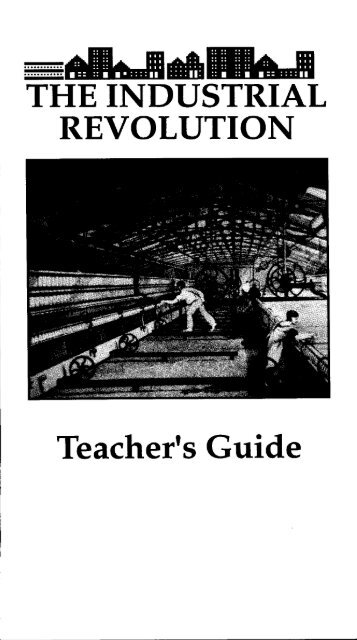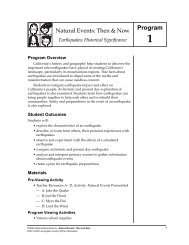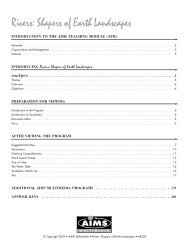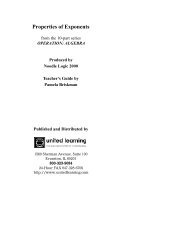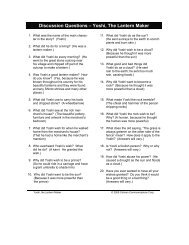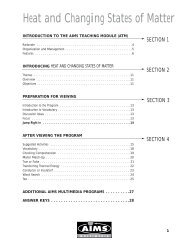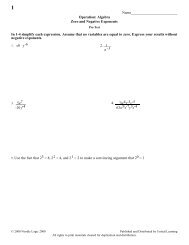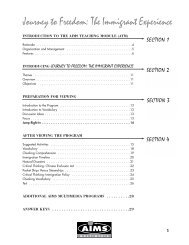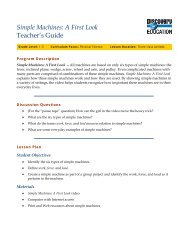The Industrial Revolution
The Industrial Revolution
The Industrial Revolution
Create successful ePaper yourself
Turn your PDF publications into a flip-book with our unique Google optimized e-Paper software.
<strong>The</strong> <strong>Industrial</strong> <strong>Revolution</strong>catalog #2236Video Produced byChariot ProductionsPublished & Distributed by…AGC/UNITED LEARNING1560 Sherman AvenueSuite 100Evanston, IL 602011-800-323-908424-Hour Fax No. 847-328-6706Website: http://www.agcunitedlearning.comE-Mail: info@agcunited.com1AGC/United Learning 1560 Sherman Av., Suite 100 Evanston, IL 60201 1-800-323-9084 Fax 847-328-6706
THE INDUSTRIAL REVOLUTIONViewing Time: 19 minutesProgram SummaryThis video-based lesson introduces students in grades 7-11 tothe major technological and social changes surrounding thefirst <strong>Industrial</strong> <strong>Revolution</strong> that began in England around 1750.As a result of events that occurred during the first <strong>Industrial</strong><strong>Revolution</strong>, civilization underwent massive and unprecedentedchanges: Cities grew, new machines that used water or coal forenergy put handcrafters out of work, people shifted their placeof work from home to factory, pollution of air and waterincreased, and the very pace of life quickened. Today, at thedawn of the 21st century, many countries are just beginning toundergo their own <strong>Industrial</strong> <strong>Revolution</strong>s, and these countriesface many of the problems confronted by the English people250 years ago.<strong>The</strong> following topics are presented in this sequence:• <strong>The</strong> Dawn of the First <strong>Industrial</strong> <strong>Revolution</strong>• Machines and Factories• Factory Work• <strong>The</strong> Steam Engine• Coal and Iron• <strong>The</strong> Development of New Cities• Improved Transportation• Into the 20th CenturyStudent ObjectivesAfter viewing this video and participating in the lesson activities,students should be able to…• Explain how the invention of new machines that could dothe work of large numbers of people changed the way peopleearned their livings and brought up their families.• Describe how the <strong>Industrial</strong> <strong>Revolution</strong> gave rise to thegrowth of cities.• Explain how the shift to factory work contributed to thegrowth of a middle class.• Contrast life before and after the first <strong>Industrial</strong> <strong>Revolution</strong>in England.2AGC/United Learning 1560 Sherman Av., Suite 100 Evanston, IL 60201 1-800-323-9084 Fax 847-328-6706
• Predict the problems and benefits awaiting those countriesthat seek to become industrialized nations.• Summarize the technological and other factors that gave riseto the first <strong>Industrial</strong> <strong>Revolution</strong>.Teacher PreparationBefore presenting the video to your students, we suggest youview the video and review this guide and the accompanyingblackline masters in order to become knowledgeable abouttheir content. You may decide to duplicate and distribute someof the blackline masters so that the students can reference themduring the video presentation. In particular, Blackline Master3, the map of <strong>Industrial</strong> England, could be very useful tostudents as they view the video. (See page 3 for a descriptionof the blackline masters supplied with this program and theanswer key for the Quiz.)As you review the instructional program outlined in this guideand the blackline masters that accompany it, you may find itnecessary to make some changes, deletions, or additions to fitthe specific needs of your class. We encourage you to do so, foronly by tailoring this program to your students will they obtainthe maximum instructional benefits afforded by the materials.Introducing the VideoIntroduce this video by describing the important historicalevents happening in the world around 1750. Focus in particularon the rise of the British Empire and on the fascination withmachines that marked the “Newtonian Era” (for Isaac Newton)--theintellectual climate of the early 18th century whenmachines were being invented for every imaginable purpose(see Follow-Up Activities, Discussion, page 3.). Let the studentsknow that few other (if any) periods of history havebrought about the magnitude of social change seen during thefirst <strong>Industrial</strong> <strong>Revolution</strong>. Finally, emphasize that todaymany countries (e.g., Central American and African countries)are actively seeking their own <strong>Industrial</strong> <strong>Revolution</strong>s in anattempt to attain prosperity and social stability.Distribute the blackline masters you’ve chosen to have studentsuse as reference (if any) and present the video—Viewingtime: 19 minutes.3AGC/United Learning 1560 Sherman Av., Suite 100 Evanston, IL 60201 1-800-323-9084 Fax 847-328-6706
Blackline Masters/Answer Key• Blackline Master 1, Vocabulary List, will help studentsbecome familiar with some of the terms referred to in thevideo presentation.• Blackline Master 2, Diagram of a Steam Engine, will showstudents a clearly defined diagram of the steam engine aspresented in the video and which represents but one of themany inventions that were introduced during the <strong>Industrial</strong><strong>Revolution</strong>. Ask for a volunteer to use the diagram toexplain how the steam engine works. Following the explanation,discuss with the class the significance of this invention.• Blackline Master 3, <strong>Industrial</strong> England, is a map of Englandshowing the major sites of the <strong>Industrial</strong> <strong>Revolution</strong>.• Blackline Master 4, is a Time Line of the <strong>Industrial</strong> <strong>Revolution</strong>showing years that correspond to specific events in theperiod covering the <strong>Industrial</strong> <strong>Revolution</strong>. This blacklinemaster is to be used for reference and discussion.• Blackline Master 5, is the Quiz for this video presentation.<strong>The</strong> following is the answer key for the quiz.1. True2. True3. False4. B5. B6. True7. False8. C9. True10. FalseFollow-Up ActivitiesDiscussion: <strong>The</strong> following questions will help spark adiscussion following the video presentation:4AGC/United Learning 1560 Sherman Av., Suite 100 Evanston, IL 60201 1-800-323-9084 Fax 847-328-6706
Q. In England, around 1750, many factors seemed to cometogether to create the <strong>Industrial</strong> <strong>Revolution</strong>. What weresome of these factors:A. Abundant coal, iron, and water power made the <strong>Industrial</strong><strong>Revolution</strong> possible. A growing demand for finished goods athome and in colonial markets inspired English merchants to seekmore efficient means of production. In the intellectual climate ofthe early 18th century, often called the Newtonian Era (for IsaacNewton), new machines were symbols of the modern enlightenedage. Machines were being invented for every imaginable purposeand those created for textile manufacturing were especiallyimportant. A single “Spinning Mule” operated by one personcould do the work of 3000 hand spinners. <strong>The</strong> Steam Enginemade it possible to build factories anywhere and to run them 24hours a day regardless of the weather.Q. How did lifestyles change as a result of industrialization?In terms of “quality of life,” what improved and whatworsened?A. In cottage industry settings, life was not so bound by rigid timeschedules and there was no commuting back and forth to work.Whole families worked together at home. As a result, youngchildren received better care and mothering. After industrialization,family life was harmed because often both mothers andchildren worked in factories. Factory work was more tediousthan work at home, but people did end up earning more money.As a result of the creation of factories, cities grew and becameovercrowded, water pollution and air pollution increased, andfarm land was torn up in order to mine iron, coal, tin, and clay.On the plus side, industrialization gave rise to a middle class withmore stable incomes, an increased life span, the right to free publiceducation, the right to have labor unions, and many other rightsthey did not possess before.Q. Today, as many parts of the world seek industrialization,certain industrial countries, such as the United States, areexporting factory work abroad where labor costs arecheaper. <strong>The</strong> talk today in the U.S. is of “high tech”industries. Computers and bio-technology are gaining inimportance while manufacturing of durable goods is indecline. Discuss the possible ramifications of this newtechnological revolution in terms of skills required tosurvive in the future workplace. Are we truly entering anew historical era some have called the “Information Age”?A. <strong>The</strong>re are no set answers to these questions but a very interestingexchange of thoughts and ideas can be stimulated by this discussion.5AGC/United Learning 1560 Sherman Av., Suite 100 Evanston, IL 60201 1-800-323-9084 Fax 847-328-6706
Use the Time Line provided on Blackline Master 4 as a discussionguide.Projects: <strong>The</strong> following are some suggestions for classinvolvement.1. Visit (as a class or in small groups) a factory to learn hownew technologies are replacing old technologies and discoverwhat impact this will have on job skills required ofthe future workforce.2. Alternatively, some towns have historic factory museumsthat are well worth a field trip. In this way, students can geta more vivid feeling for the <strong>Industrial</strong> <strong>Revolution</strong>.3. Assign small groups to carry out library research on theIndusrial <strong>Revolution</strong> in the United States or Canada, orwithin their own town, state, or province. Written or oralreports could focus on social changes, technologicalchanges, environmental problems resulting from industrializationfor these specific locales.4. Assign small groups to carry out library research in orderto pinpoint specific countries where little or no industrialization has yet occurred. Students should evaluate thereasons for the lack of industrialization and analyze whatsome of these countries stand to gain or lose in terms ofquality of life as a result of industrialization.Optional Project: Assign other small groups to use theresearch done by the above formed groups to compare andcontrast countries that are just now undergoing their ownindustrial revolution with English cities over 250 yearsago. This activity will require teamwork, cooperation, andcommunication.5. Have students write short essays on topics such as…• Daily life of a factory worker during the <strong>Industrial</strong><strong>Revolution</strong>.• Child labor laws and practices in the middle 1700s.• How the <strong>Industrial</strong> <strong>Revolution</strong> helped England to be aworld power.• Cottage industry• Spinning Jenny6AGC/United Learning 1560 Sherman Av., Suite 100 Evanston, IL 60201 1-800-323-9084 Fax 847-328-6706
6. Display and Presentation: Ask for volunteers, or select asmall group, to gather a display using artwork, pictures,models, etc. (encourage creativity) to depict some of thetools and machines developed and/or used during the<strong>Industrial</strong> <strong>Revolution</strong>. <strong>The</strong>n let the group select a spokespersonto give an oral presentation to the class using thedisplay. (You could also have another group do the samething but show the old methods used before industrialization.)Script of Video NarrationAn <strong>Industrial</strong> <strong>Revolution</strong> is a time in a countries history whenit undergoes a rapid change from an agricultural to a factorybasedeconomy.<strong>The</strong> first <strong>Industrial</strong> <strong>Revolution</strong> began in England around theyear 1750 and proceeded, over many decades, to transform notonly that countries landscape, but the entire fabric of hersociety as well.Let us step back in time and discover what caused thesemassive and unprecedented changes to occur in that smallcountry.<strong>The</strong> Dawn of the First <strong>Industrial</strong> <strong>Revolution</strong>To picture England before the <strong>Industrial</strong> <strong>Revolution</strong>, we mustimagine a nation that was the most powerful on earth, and yetpossessed no real factories; a country that had just one largecity, London. For the most part, England was a quiet and lovelyland of farms and rural villages where only the sounds ofweather, of animals, and the distant ringing of churchbellsbroke the stillness of the landscape.Yet, England was a land of great social inequality. A handfulof aristocrats owned most of the land and possessed, by rightof birth, nearly all of the incredible wealth it yielded. <strong>The</strong>y builtmagnificent palaces for themselves and filled them with treasures,while an enormous lower class, most of whom owned noland, struggled to survive...often paying rent to the wealthylandowners. <strong>The</strong>se poor people sometimes faced severe malnutritionand even starvation. <strong>The</strong>y usually died young.With this as a background, let us find out what great changesAGC/United Learning 1560 Sherman Av., Suite 100 Evanston, IL 60201 1-800-323-9084 Fax 847-328-67067
were to occur as a result of industrialization.<strong>The</strong> first <strong>Industrial</strong> <strong>Revolution</strong> began in England for severalreasons. First, she possessed rich deposits of iron and coal--resources essential to industrialization. Second, England hadmany reliable sources of water power. And third, numerouscolonies around the world supplied her with abundant rawmaterials, like this cotton, and at the same time, they providedan enormous captive market for her manufactured goods, likethis cloth.<strong>The</strong>se colonial markets helped to stimulate the British textileand iron industries, and in the beginning, it was the wealthproduced by these two industries that drove the <strong>Industrial</strong><strong>Revolution</strong>.During the mid 18th century, the growing demand for goods,such as the iron and coal seen here, resulted in greater competitionamong manufacturers, and as costs of production rose,manufacturers sought new ways of meeting the increaseddemand for their products without raising prices.Machines and FactoriesIn many ways, the story of the <strong>Industrial</strong> <strong>Revolution</strong> is a storyof human ingenuity; of people finding new ways to use thesources of energy available to them and to profitably link thesesources of energy with marvelous new machines that couldmore efficiently perform tasks that in the past had requiredlong hours of hand labor.Let us look at one example of how machinery can save labor inthe grinding of grain into flour. <strong>The</strong> traditional way of grindinggrain, a method still in use in some parts of North America, isto simply rub the grain between two stones.Ancient European people used similar methods of makingflour until, at some point many centuries before the <strong>Industrial</strong><strong>Revolution</strong>, it was discovered that the power of the wind couldbe captured and used to turn grinding stones. Likewise, it wasdiscovered that a flowing stream could also be used to turn awater wheel that, in turn, could move the millstone.<strong>The</strong>se mills for producing flour are some of the oldest factories,for they replaced home-based, hand-powered flour making8AGC/United Learning 1560 Sherman Av., Suite 100 Evanston, IL 60201 1-800-323-9084 Fax 847-328-6706
and the workers who operated them.With the creation of factories, the way that people lived beganto change. Since the machines were too large and complicatedto be placed in a cottage, it became necessary for this newgeneration of workers to travel to the new factories for employment.This shift from home to factory-based work was todramatically alter English society as poor farm workers andunemployed weavers and spinners left the countryside seekingdependable employment in newly-forming industrial centers.Factory WorkFactory work was much different from the system of cottageindustry. Under the old system, cloth merchants had a fairlyclose relationship with their workers and generally took aninterest in their well-being. But, large factories and rigid productionschedules did not allow for much familiarity betweenowners and workers, and factory work was more tiring thanhome manufacturing, even though the factories kept the same12-14 hour work schedule six days a week that the cottageworkers had followed. Factory work had greater productiondemands, was very monotonous, and few breaks were allowed.Plus, working conditions in factories were much worsethan in cottage settings.Many of the earliest factories, referred to by labor reformers asthe “dark satanic mills,” were noisy and dangerous places inwhich to work--full of dust and fumes that often resulted inpermanent physical damage to workers.Children, robbed of their childhoods, worked long hours in themills….and women and children were paid only a fraction ofwhat the men earned.Many mill owners believed that the lower classes had to be keptpoor in order to make them industrious. But even thoughwages were low, at least workers could rely on them so thatthey rarely faced the extreme poverty they had known in thepast.Although the working classes did not at first share in the wealthcreated by the <strong>Industrial</strong> <strong>Revolution</strong>, the middle and upperclasses prospered and great fortunes were made as wealth10AGC/United Learning 1560 Sherman Av., Suite 100 Evanston, IL 60201 1-800-323-9084 Fax 847-328-6706
shifted from the hands of land-owning aristocrats to factoryowningcapitalists.One famous social critic of the time, who worked to bring aboutchanges in the law to benefit the poor working classes, wasCharles Dickens. His books offer vivid portrayals of life duringthe first <strong>Industrial</strong> <strong>Revolution</strong>. And Karl Marx, a Dickenscontemporary who lived in England for much of his early life,wrote his two famous books, “Das Capital” and “<strong>The</strong> CommunistManifesto," in response to the social injustices he witnessedas a result of industrialization.During the time of Marx and Dickens, many factories hadswitched to coal instead of water as a source of power. <strong>The</strong>problem with using water or wind to run machines was thatthey could be unreliable sources of energy. A windmill couldn’toperate on windless days, and a water-powered factory cameto a complete halt during dry spells.<strong>The</strong> Steam EngineFor this reason, a new invention called the steam engine cameinto wide use in factories and, because it used coal for fuel, itwas no longer necessary to build factories next to rivers.Although steam engines had begun to be used to run machinesas early as the 1720s, it wasn’t until the late 1700s that steampower started to be used in factories really efficiently.A steam engine works like this: Water is heated by wood or coalin a boiler. As steam is produced, the pressure in the boilerincreases. By turning a handle, the steam enters the enginethrough a valve. <strong>The</strong> steam pressure then pushes the pistondown, which in turn moves a heavy flywheel. <strong>The</strong>n the pistonis returned to its starting position as high pressure steampushes on the other side of the piston. When the engine isrunning at full speed, the piston moves back and forth veryrapidly. Pulleys or gears attached to the flywheel can then beused to run almost any kind of machine.Coal and Iron<strong>The</strong> need for more coal and iron increased dramatically asorders for more manufactured goods poured into businessoffices. Coal was needed, not just to run steam engines, but foriron making and heating. More iron was needed to make moremachines and steam engines, as well as iron goods, like toolsAGC/United Learning 1560 Sherman Av., Suite 100 Evanston, IL 60201 1-800-323-9084 Fax 847-328-670611
and cookware. So it was that the <strong>Industrial</strong> <strong>Revolution</strong>’sappetite for coal went hand in hand with its appetite for iron.<strong>The</strong> interdependence of iron and coal use can easily be seenhere in this coal mine. <strong>The</strong> coal is lifted out of the pit by a steamengine. <strong>The</strong> steam engine uses coal for fuel and is made fromiron parts cast in the iron works nearby. Nearly all the machinesof the <strong>Industrial</strong> <strong>Revolution</strong> were made mainly of iron,and coke made from coal was the basic fuel burned to melt theiron ore.<strong>The</strong> Development of New CitiesBefore improvements in transportation, factories were built inareas where iron and coal mines were close at hand. <strong>The</strong>se areaswhere mines, factories, and workers crowded together, developedinto industrial cities, and they almost immediately becamedifficult places in which to live. Here the water and airbecame terribly polluted as dark clouds of smoke poured fromfactory chimneys, from ovens where coal was converted intocoke, and from the fireplaces in the simple homes of thousandsof miners and factory workers.Everything was covered with a dark layer of soot. <strong>Industrial</strong>waste and sewage fouled the rivers and streams, and the landthat only recently had been green and fertile was torn up asmore and more mines and factories appeared and new rows ofworkers houses sprouted up in the nearby fields.<strong>The</strong>se industrial towns were dreary, overcrowded, and unhealthyplaces to raise a family, but eventually changes startedto be made to benefit the workers. A handful of enlightenedindustrialists created a few “model” villages for workers, andthese were a great improvement over how they had livedbefore.Later in the 19th century, many other social improvementsfollowed. Laws banning labor unions were repealed, and childlabor was outlawed.Although there were plenty of economic bad times, the workingclasses had reached a point where they sometimes hadextra money to spend. In fact, they now made up a vast newmarket for the manufactured goods they helped produce.Wealth, it seemed, created more wealth. Free public schools12AGC/United Learning 1560 Sherman Av., Suite 100 Evanston, IL 60201 1-800-323-9084 Fax 847-328-6706
were instituted all across England for the very first time,resulting in the first working class generation that was able toread and write. <strong>The</strong>se new educational skills provided someyoung people with a ticket away from a dreary future in themines and factories to better paying, less monotonous jobs.Improved Transportation<strong>The</strong> rising prosperity that accompanied industrialization alsobrought improvements in transportation.First the roads, that in the past were often little better than crudemuddy tracks, were improved to handle more traffic, and newbridges were constructed, some made entirely of iron for thevery first time.As early as 1761, an intricate system of canals and locks beganto be constructed so that barges could carry fuel and rawmaterials from mines to factories and finished goods fromfactories to city warehouses.As early as 1825, steam engines were being used to turn thewheels of locomotives that moved along steel tracks at theunheard of speed of 15 miles per hour. Also, by that time, steampowered ships were beginning to travel the seas--no longerdependent on the ever-changing winds. And late in the 19thcentury, as huge parts of North America and Europe completedthe transition to an industrial society, steam-poweredfarm machines, from tractors to hay bailers, revolutionizedfarming. And by the start of the 20th century, the United Stateshad ovetaken England to become the world’s leading industrializednation.Into the 20th CenturyFrom the 1880s through the first decade of the 20th century,many new and incredible inventions radically changed theway people lived. Horse and steam-powered vehicles wereabandoned for more efficient, gasoline-powered vehicles runby internal combustion engines. Thomas Edison’s phonographbrought music into the homes; and motion pictures to thetheaters; and his light bulb brightened up the nights. <strong>The</strong>airplane allowed humans to fly through the air, and by usingan assembly line of workers, Henry Ford was able to massproduce automobiles so inexpensively as to make them affordableto average working Americans.AGC/United Learning 1560 Sherman Av., Suite 100 Evanston, IL 60201 1-800-323-9084 Fax 847-328-670613
This new world of the early 20th century had arrived as a resultof the first <strong>Industrial</strong> <strong>Revolution</strong>. It was busy, crowded, noisy,and exciting. In less than two centuries, a peaceful rural way oflife had been replaced by a truly new style of living. And todaymany parts of the world still await the coming of industrializationwith all its benefits and problems.As these new industrial revolutions take hold, traditionalagricultural ways of life will be traded for the security of factoryjobs…as quiet landscapes are transformed by the smoke, thenoise, and the hectic pace of life that followed the first <strong>Industrial</strong><strong>Revolution</strong> in England two hundred fifty years ago.14AGC/United Learning 1560 Sherman Av., Suite 100 Evanston, IL 60201 1-800-323-9084 Fax 847-328-6706
AGC/United Learning1560 Sherman Avenue, Suite 100Evanston, Illinois 60201(800) 323-9084, Fax (847) 328-6706http://www.agcunitedlearning.come-mail: info@agcunited.comAGC/United Learning 1560 Sherman Av., Suite 100 Evanston, IL 60201 1-800-323-9084 Fax 847-328-670615<strong>The</strong> <strong>Industrial</strong> <strong>Revolution</strong>Catalog #2236ISBN No. 1-56007-398-5


